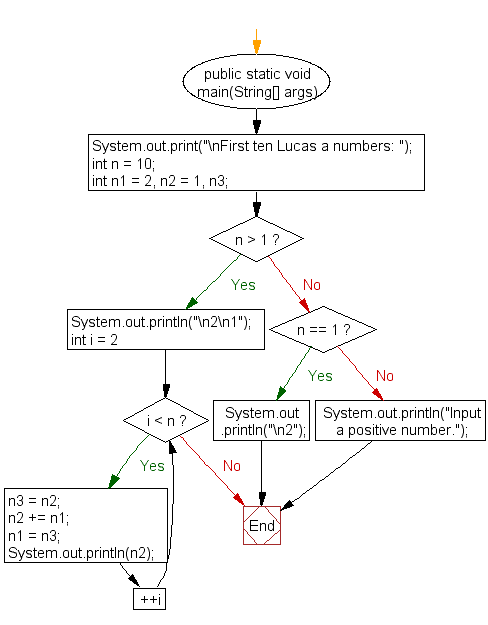Java: Display first 10 lucus numbers
First 10 Lucas Numbers
Write a Java program to display the first 10 lucus numbers.
The Lucas numbers or series are an integer sequence named after the mathematician François Édouard Anatole Lucas, who studied both that sequence and the closely related Fibonacci numbers. Lucas numbers and Fibonacci numbers form complementary instances of Lucas sequences.
The sequence of Lucas numbers is: 2, 1, 3, 4, 7, 11, 18, 29, ….
Sample Solution:
Java Code:
import java.util.Scanner;
public class Example7 {
public static void main(String[] args) {
System.out.print("\nFirst ten Lucas a numbers: ");
int n = 10;
int n1 = 2, n2 = 1, n3;
if (n > 1){
System.out.println("\n2\n1");
for(int i = 2; i < n; ++i){
n3 = n2;
n2 += n1;
n1 = n3;
System.out.println(n2);
}
}
else if (n == 1)
System.out.println("\n2");
else
System.out.println("Input a positive number.");
}
}
Sample Output:
First ten Lucas a numbers: 2 1 3 4 7 11 18 29 47 76
Flowchart:

For more Practice: Solve these Related Problems:
- Write a Java program to compute Lucas numbers using recursion with memoization for efficiency.
- Write a Java program to generate Lucas numbers iteratively and then print them in reverse order.
- Write a Java program to compute the ratio of consecutive Lucas numbers and analyze their convergence.
- Write a Java program to compare Lucas and Fibonacci numbers by outputting their differences for the first 10 terms.
Go to:
PREV : First 15 Narcissistic Numbers.
NEXT : First 10 Catalan Numbers.
Java Code Editor:
Contribute your code and comments through Disqus.
What is the difficulty level of this exercise?
Test your Programming skills with w3resource's quiz.
